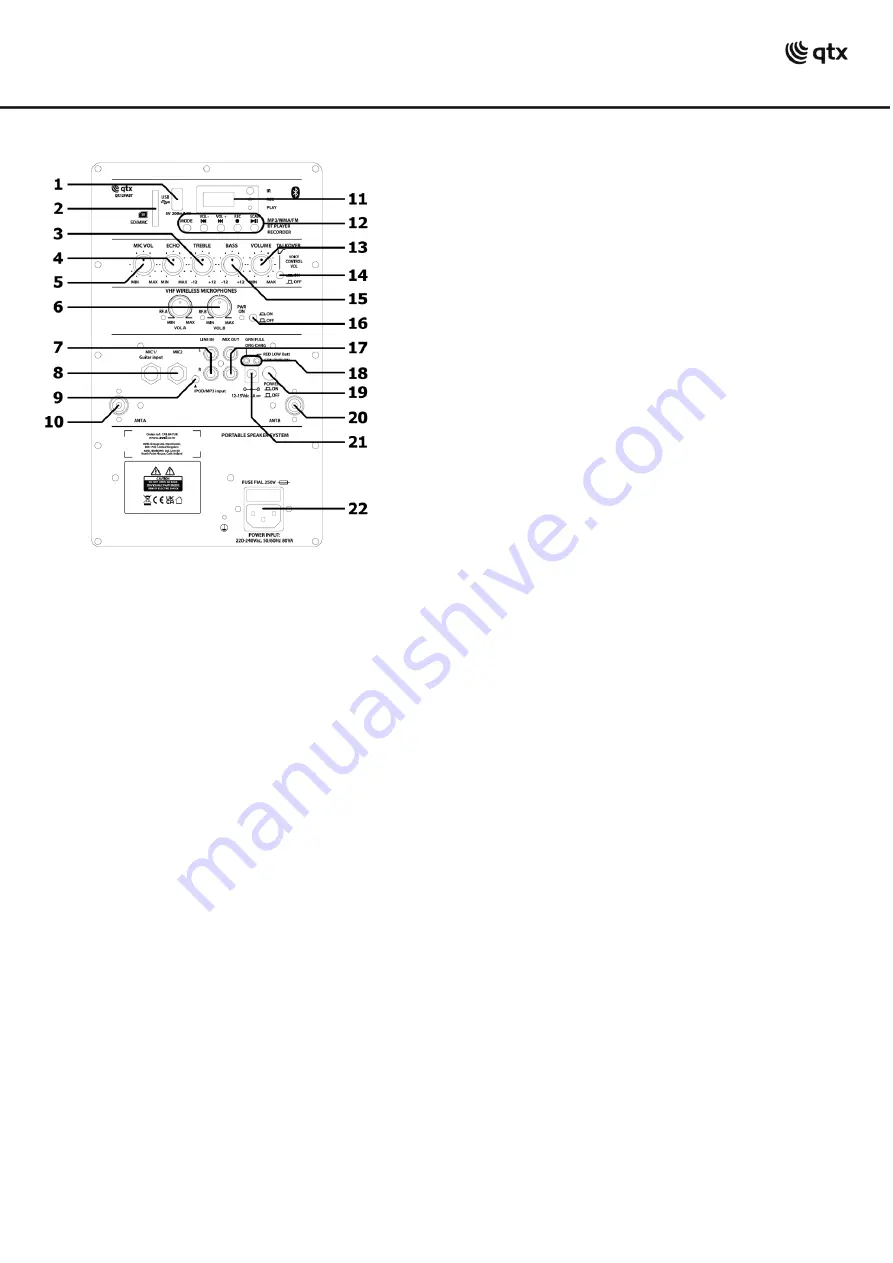
178.847UK, 178.848UK User Manual
Control panel
Powering up
Your new QRPABT unit may arrive with you with the internal battery charged. Before connecting to the mains with the
supplied power adaptor, switch the unit on and check the POWER LED (18). If it is green, there is charge in the battery.
If it is red, then you will need to charge the battery before using away from a mains supply.
Connect the QRPABT unit to the mains using the supplied IEC mains lead (22). You may otherwise opt to connect the DC
input jack (21) to an external 12-15Vdc supply, such as a car battery, or use the internal battery if charged.
When not in use but connected to the mains, if the POWER switch is in the
off
position, the internal battery will be re-
charged from the mains supply. This can be observed by the CHARGE LED (18), which will light orange when charging.
When fully charged, the CHARGE LED will change to green.
Note:
it is recommended to store the PA unit at an ambient temperature and not with the battery fully discharged.
Initial setup
Turn all VOLUME & ECHO controls down (anti-clockwise) and turn the POWER switch on (the power LED should light).
BASS and TREBLE controls should remain pointing vertically (12-o-clock position).
Turn up the main VOLUME control part way and switch VCV off. Your QRPABT unit should now be ready to operate.
VHF Microphone
Insert the supplied AA batteries into each of the handheld microphones by carefully unscrewing the base and connecting
the “+” and “
-
” terminals o
f the battery to the corresponding contacts inside the microphone body, taking care to observe
the correct polarity. Turn on the VHF receiver (16) and turn the VHF VOL controls (6) up (clockwise) part way.
Switch on each wireless mic in turn
–
the rear panel RF LEDs should light as a result. If the LED on the transmitter lights
dimly, change the battery. Gradually increase the VHF VOL controls (6), testing each microphone for output through the
speaker. Take care not to incur “feedback” (howling or screeching sound through the speaker) by keeping the
microphone a sensible distance
from the speaker and pointing away from the speaker so that it doesn’t
hear
the speaker.
Turning the ECHO control (4) clockwise introduces a pre-set echo function for singing and special effects.
BASS and TREBLE (15, 3) can be cut by turning anti-clockwise or boosted by turning clockwise.
When not in use, switch the handheld transmitters off and remove the batteries if not being used for long periods.
1
USB port
2
SD/MMC card slot
3
TREBLE EQ
4
ECHO level
5
Wired MIC / guitar volume
6
VHF Mic volumes A and B
7
LINE IN 2 x RCA
8
Wired MIC.1 / guitar and MIC.2 input 6.3mm jacks
9
Smart phone / aux input stereo 3.5mm jack
10 Antenna connection - VHF Mic A
11 Media player LCD display & IR receiver
12 Media player mode & transport controls
13 Main volume
14 VCV talkover on/off
15 BASS EQ
16 VHF wireless receiver on/off
17 MIX OUT line output 2 x RCA
18 Battery charge & power LEDs
19 Power on/off
20 Antenna connection - VHF Mic B
21 DC power input jack
22 IEC power inlet & fuse holder






















